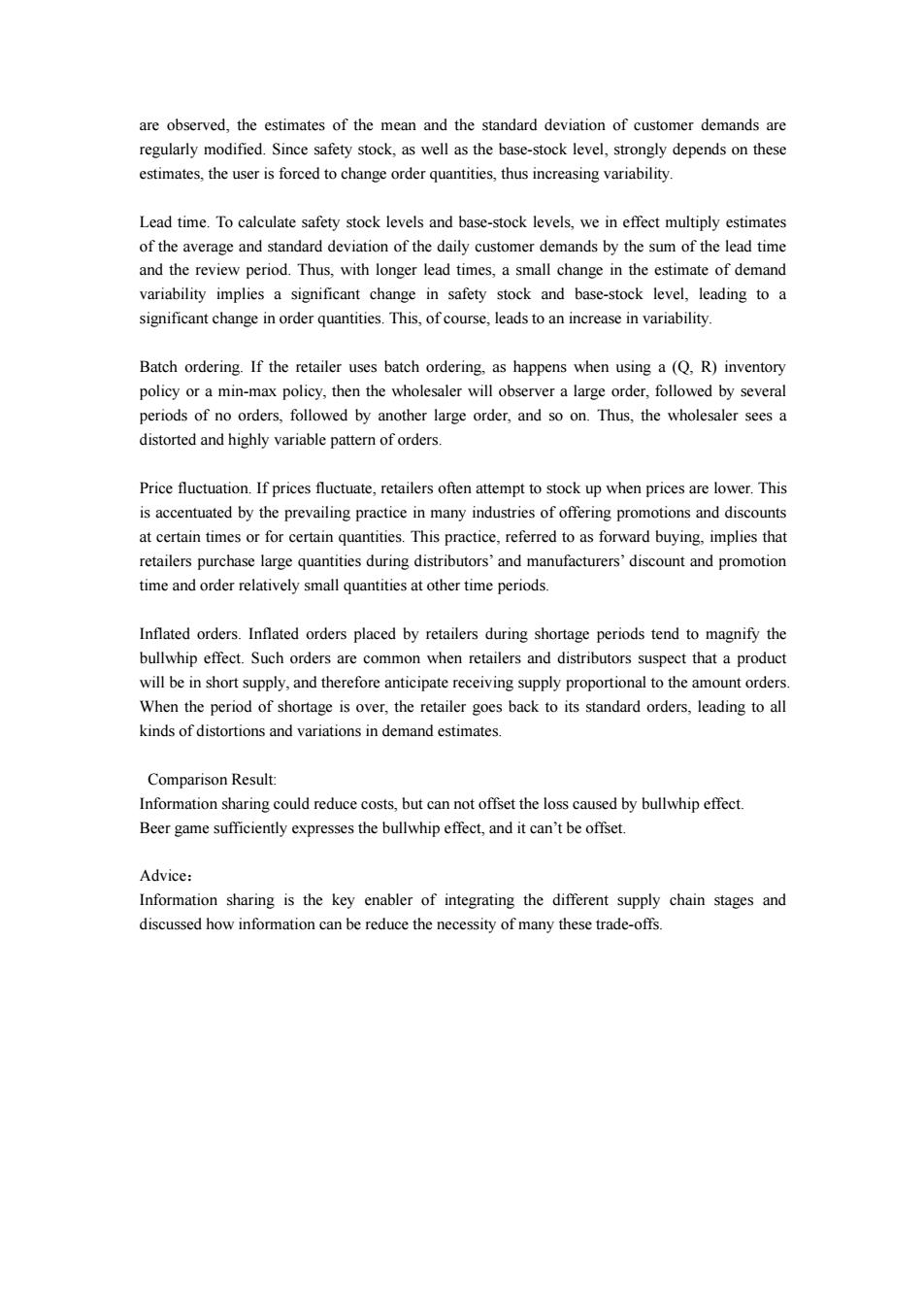正在加载图片...

are observed,the estimates of the mean and the standard deviation of customer demands are regularly modified.Since safety stock,as well as the base-stock level,strongly depends on these estimates,the user is forced to change order quantities,thus increasing variability. Lead time.To calculate safety stock levels and base-stock levels,we in effect multiply estimates of the average and standard deviation of the daily customer demands by the sum of the lead time and the review period.Thus,with longer lead times,a small change in the estimate of demand variability implies a significant change in safety stock and base-stock level,leading to a significant change in order quantities.This,of course,leads to an increase in variability. Batch ordering.If the retailer uses batch ordering,as happens when using a(Q,R)inventory policy or a min-max policy,then the wholesaler will observer a large order,followed by several periods of no orders,followed by another large order,and so on.Thus,the wholesaler sees a distorted and highly variable pattern of orders. Price fluctuation.If prices fluctuate,retailers often attempt to stock up when prices are lower.This is accentuated by the prevailing practice in many industries of offering promotions and discounts at certain times or for certain quantities.This practice,referred to as forward buying,implies that retailers purchase large quantities during distributors'and manufacturers'discount and promotion time and order relatively small quantities at other time periods. Inflated orders.Inflated orders placed by retailers during shortage periods tend to magnify the bullwhip effect.Such orders are common when retailers and distributors suspect that a product will be in short supply,and therefore anticipate receiving supply proportional to the amount orders When the period of shortage is over,the retailer goes back to its standard orders,leading to all kinds of distortions and variations in demand estimates. Comparison Result: Information sharing could reduce costs,but can not offset the loss caused by bullwhip effect. Beer game sufficiently expresses the bullwhip effect,and it can't be offset. Advice: Information sharing is the key enabler of integrating the different supply chain stages and discussed how information can be reduce the necessity of many these trade-offs.are observed, the estimates of the mean and the standard deviation of customer demands are regularly modified. Since safety stock, as well as the base-stock level, strongly depends on these estimates, the user is forced to change order quantities, thus increasing variability. Lead time. To calculate safety stock levels and base-stock levels, we in effect multiply estimates of the average and standard deviation of the daily customer demands by the sum of the lead time and the review period. Thus, with longer lead times, a small change in the estimate of demand variability implies a significant change in safety stock and base-stock level, leading to a significant change in order quantities. This, of course, leads to an increase in variability. Batch ordering. If the retailer uses batch ordering, as happens when using a (Q, R) inventory policy or a min-max policy, then the wholesaler will observer a large order, followed by several periods of no orders, followed by another large order, and so on. Thus, the wholesaler sees a distorted and highly variable pattern of orders. Price fluctuation. If prices fluctuate, retailers often attempt to stock up when prices are lower. This is accentuated by the prevailing practice in many industries of offering promotions and discounts at certain times or for certain quantities. This practice, referred to as forward buying, implies that retailers purchase large quantities during distributors’ and manufacturers’ discount and promotion time and order relatively small quantities at other time periods. Inflated orders. Inflated orders placed by retailers during shortage periods tend to magnify the bullwhip effect. Such orders are common when retailers and distributors suspect that a product will be in short supply, and therefore anticipate receiving supply proportional to the amount orders. When the period of shortage is over, the retailer goes back to its standard orders, leading to all kinds of distortions and variations in demand estimates. Comparison Result: Information sharing could reduce costs, but can not offset the loss caused by bullwhip effect. Beer game sufficiently expresses the bullwhip effect, and it can’t be offset. Advice: Information sharing is the key enabler of integrating the different supply chain stages and discussed how information can be reduce the necessity of many these trade-offs